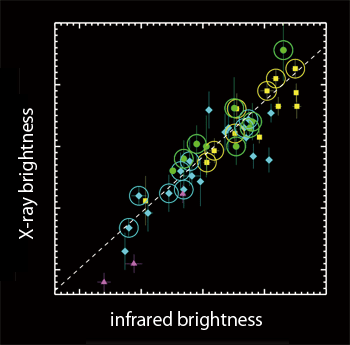TOP > Report & Column > The Forefront of Space Science > 2010 > THE BEAUTY OF BLACK HOLES
![]()

I led a team to observe many bright super massive sources in galaxies located only about 100 million light years away -- very close by in astronomical terms. We used a state-of-the-art camera that can detect infrared light, because cold accreting clouds of gas and dust are strong infrared emitters. At the same time, the good resolving power of the telescope allowed us to separate of the stars in the galaxy from the clouds accreting on to the black hole, giving us a good measurement of the intrinsic brightness of these sources for the first time. Even the weakest source was emitting as much power as 300 million Suns put together! But what is the mechanism generating such phenomenal energies? Some important insight comes from comparing the observed infrared light with the X-ray light from these black holes, as in Figure 4. It can be seen that there is a very tight connection between the two emitted powers. As I mentioned before, X-rays arise from the hottest inner regions very close to the black hole itself. Like heat from an extremely hot oven, this radiation illuminates and heats up any surrounding matter clouds, in this case causing the innermost clouds to be warmed up to temperatures of ~1000 degrees when they naturally emit infrared light. 
A lot of clues are contained in such physical correlations and just like the famous detective Sherlock Holmes, we must not miss any of them if we are to uncover all the secrets of black holes. For example, the fact that X-ray and infrared light are so closely related can tell us about the nature of the accreting clouds themselves. Imagine that the clouds are completely uniform and thick so that our view of the black hole itself is fully obscured. In this case, we would not see the hottest inner clouds, and so the source would appear relatively faint in the infrared at any given X-ray power. In a large sample of galaxies selected randomly, we would thus expect the infrared to X-ray power ratio to change a lot. But Fig. 3 shows a tight infrared:X-ray ratio throughout. This can be explained if, instead of a uniform thick cover, there are some gaps and holes between the clouds, so that the innermost hot regions are always visible to us. Such a 'clumpy' distribution of clouds (Figure 5) has been predicted for many years, but our new observations now give the first good evidence for its existence. 
In summary We are making great strides in understanding black holes, but this field is still young, and there remains much to be done. The general perception of these sources may be as 'monsters' of nature, but to me they are also objects of great beauty, able to generate phenomena unseen anywhere else in space. Gandhi Poshak
|
||||||||||




